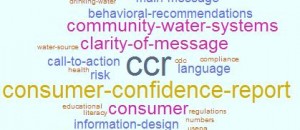What a Water Quality Report tells you?

By Katherine Phetxumphou, Department of Civil and Environmental Engineering, member of Water IGEP, Virginia Tech
Have you ever received a water quality report in the mail and wondered what in the world it was trying to tell you?
Well, you are not alone! Water IGEP researchers (PhD students: Katherine Phetxumphou and Sid Roy; Professors: Brenda M. Davy, Andrea Dietrich, Paul Estabrooks, Wen You) evaluated a national sample of Consumer Confidence Reports (CCRs), better known as water quality reports, that are federally mandated by the US EPA for water utilities to release by July 1st of every year. They analyzed the clarity of message communication of these reports using the CDC’s Clear Communication Index tool and also rated the reading levels using Flesch-Kincaid readability tests. Results revealed that all of the CCRs failed at communicating a main message. Additionally, these reports rated at 11th to undergraduate grade levels, which are much higher than the National Institutes of Health’s recommended 6th-7th grade reading levels for health communications.
The researchers urge the US EPA to reevaluate the CCR rule and report formats and main messages. Presenting and highlighting a main message like, “The water is safe to drink according to all federal and state regulations,” will allow consumers like you and I to make informed decisions about our drinking water. Presenting CCRs that are clearly written at the recommended grade levels will also ensure consumers are effectively processing information on the quality of their drinking water.
For more information, please:
- Refer to our recent press release: https://www.vtnews.vt.edu/articles/2016/03/030116-fralin-waterquality.html AND/OR
- Refer to our two published journal articles:
- http://jwh.iwaponline.com/content/early/2015/11/11/wh.2015.134
- http://jwh.iwaponline.com/content/13/3/645


